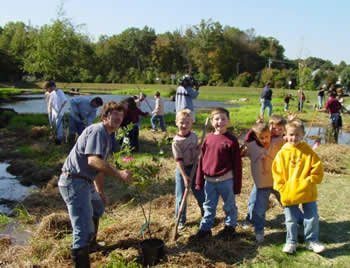Green infrastructure is a nature-based approach that uses a combination of engineering and nature’s own systems to address environmental challenges like erosion, flooding, and air and water pollution.
Plants and soils naturally filter pollutants out of water and air, and absorb rain and stormwater to reduce flooding and runoff after storms. Plants also lock their roots into the soil, preventing erosion, and absorb nutrients that can be carried off of land.
Green infrastructure — including rain gardens, green roofs, living shorelines, and others — maximizes on these services that nature already provides through strategic placement, protection, and development.
The Green Infrastructure Primer developed by the DNREC Division of Climate, Coastal and Energy provides an introduction to green infrastructure projects and their benefits, as well as information on selecting, building, and maintaining them. These web pages provide an overview of the benefits of green infrastructure and an introduction to site-scale and landscape-scale projects. The Primer itself includes a complete list of resources. The resources list includes information and contacts for regulatory and permitting assistance, planning and technical help, and funding resources. It includes links to more detailed documents and information about mapping and geospatial data resources.
For a printed copy of the primer, contact the Division of Climate, Coastal and Energy at 302-735-3480.

Green Infrastructure is essential to protecting Delaware’s citizens, economy, and vibrant natural resources. Green infrastructure is an investment in our state’s future. Former Governor Jack Markell issued an Executive Order in 2013 directing state agencies to prioritize natural systems and green infrastructure as strategic tools for building Delaware’s resiliency in the face of climate change. Delaware’s focus on using natural systems to balance development and environmental stewardship extends back to former Governor Ruth Ann Minner’s “Livable Delaware” initiative.That initiative emphasized that it is easier and more cost-effective to protect natural resources and processes than to restore them after they are damaged.
The state of Delaware supports green infrastructure projects at the site and landscape scales. At the site scale, the Department of Natural Resources and Environmental Control has tools, resources, and knowledgeable staff committed to working with municipalities, individuals, and commercial property owners to create and maintain green infrastructure. At the landscape scale, inter-departmental efforts work to preserve natural spaces and protect native plants and animals, as well as water, air, and land resources, incorporating ecological assessment and environmental values into state planning and land use decisions.
Related Topics: climate, energy, green infrastructure, natural, sustainability